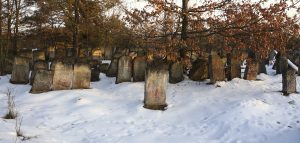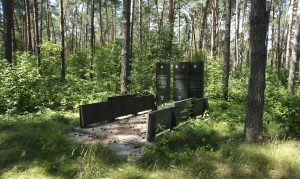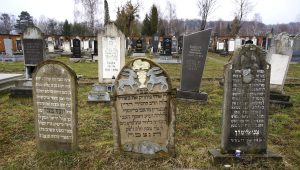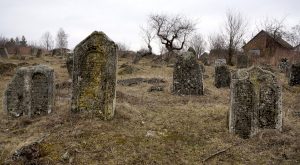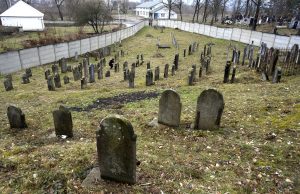![]() Ця сторінка також доступна українською.
Ця сторінка також доступна українською.
Introduction and Scope
To date, there is no comprehensive source for data about Jewish burial sites in Europe generally, or more narrowly covering the focus of this website, western Ukraine. Numerous organizations have identified some or many cemeteries and/or wartime mass graves, and most of those publish their information on the web, but currently none of the websites are complete, few sites link to each other, and there is no simple way to combine data from the several significant sites into a coherent whole. This section of this website is intended as an aggregate resource of western Ukraine regional Jewish cemeteries data, and a link to the major data sources, in the hope that this may serve anyone working directly or indirectly to recognize, preserve, and protect these sites of Jewish and Ukrainian heritage.
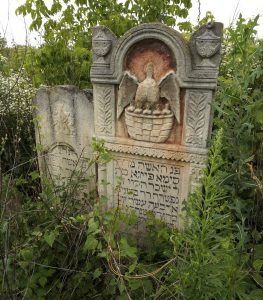
An unusual symbol on a headstone in the Jewish cemetery in Chernivtsi (Chernivtsi oblast). Photo © RJH.
This section refers to identified Jewish burial sites rather than documented sites, as there are many ways to document the sites, and many levels of documentation completeness. Our primary aim is to identify specific locations as comprehensively as we can from other sources and our own research on the ground. However, in addition to identifying locations, some of the sources linked here also describe the history of the sites and include photographs and sometimes much more.
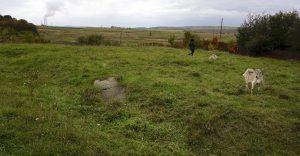
A rare recovered headstone in the Jewish cemetery of Bilshivtsi (Ivano-Frankivsk oblast). Photo © RJH.
For this index, the scope comprises only Jewish burial sites, including both pre-war and post-war cemeteries plus wartime mass graves. Jews consider all burial sites of any size as cemeteries deserving of respect and protection, no matter the circumstances of the death and burial, so we aim to be comprehensive here even though identification and documentation of some sites is still lacking. Burial sites which some call erased or desolated (because all headstones were removed during or after WWII) are included here, as are sites which some call destroyed (because the land has been built over or otherwise re-purposed, sometimes with the removal of human remains) are also included, where information is available.
Jewish physical heritage objects including synagogues and related community buildings are not tabulated here, as there are other projects which have already covered that topic quite well; see for example the dense European historic synagogues map and database by the Center for Jewish Art and the Foundation for Jewish Heritage.
The index scope is also limited geographically to western Ukraine only, specifically to three oblasts (administrative units corresponding to states in some other countries). The three included oblasts, linked below, comprise major parts of historical eastern Galicia. For each oblast, a tabulated index organizes the identified cemeteries by the associated modern Ukrainian town/village name and the current district (raion or significant city) in which they are located, with GPS coordinates (and a link to a digital map) together with links to additional data from our major sources. To date the number of identified burial sites in the three oblasts exceeds 500 cemeteries and mass graves.
Known current or former heritage projects at some of the sites are not indicated in these lists; a separate table lists those projects with links to additional project information, where available.
This section of the website is not intended to be another competing database of Jewish heritage, but rather an aggregate of and link to existing and growing databases, to highlight gaps in coverage and to promote recognition of burial sites, especially the lesser-known ones.
Jewish Burial Grounds: Link Lists by Oblast
Identified Jewish cemeteries and mass graves are organized by their current oblasts in western Ukraine:
Throughout these pages, a number of images are shown of Jewish burial sites in the above oblasts. Images are also shown of cemeteries and mass graves in the neighboring Chernivtsi and Zakarpattia oblasts (historically part of northern Bukovina and Carpathian Ruthenia), which share some history and culture with former eastern Galicia.
Information Sources
Most of the information in these indexes comes from a handful of sources, but there is a large number of smaller sources with focused information and often with different, sometimes richer information, images, etc. Several sources have project scope well beyond western Ukraine, into much of central and eastern Europe and beyond. As noted below, two of the largest sources linked here are working with institutional funding and/or crowd-sourcing in an effort, as one source describes, “to document every Jewish burial site in the world.” At least within our small corner of the world, we see rapid progress toward comprehensive coverage, and we are encouraged by the efforts.
Below are links to and brief descriptions of the major sources in our tables plus a number of other sources which may be helpful in further research. Each source is listed by its shorthand name in the tables as well as its full name.
.
Sources Included in the Tables:
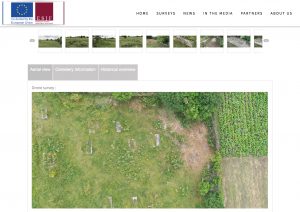
A screenshot of a portion of the ESJF survey data for Probizhna (Ternopil oblast).
ESJF = European Jewish Cemeteries Initiative
A German non-profit organization begun in 2015, ESJF works to protect Jewish cemeteries in Europe. Their first project, funded by a grant from the German federal government, includes surveys and assessment of cemetery boundaries and the construction of walls or fencing around selected cemeteries; Ukraine is part of both the survey work and the fencing work, which continues. Ukraine is also represented in a large pilot project funded by the EU for 2019-2020 to survey 1500 Jewish cemetery sites across five countries and create costed proposals for protection; the project also includes an education component to encourage discovery and protection of Jewish sites by local secondary school students. The Ukraine cemetery surveys have identified more than 900 Jewish burial sites overall and over 200 cemeteries in western Ukraine; online documentation includes a historical overview including interwar and earlier maps, each site’s GPS location, photographs at ground level and from aerial drones, boundary and area measurements, a summary count of surviving headstones, and an assessment of current risks. Although not the largest, this growing database is the most accurate resource for Jewish burial site identification and location. ESJF’s 2018-2020 cemetery survey work in Ukraine allowed the organization to compile a set of very valuable statistics about Jewish cemeteries across the country and analyzed by oblast, providing useful context for both planning and communication on individual cemetery projects.
IAJGS = IAJGS International Jewish Cemetery Project
A global project of the International Association of Jewish Genealogy Societies (IAJGS) and their web project JewishGen, the section for Ukraine (Eastern Europe) presents the data compiled in a lengthy 2005 report from the US Commission for the Preservation of America’s Heritage Abroad by the region’s research director, Samuel Gruber, based on a field survey conducted by the Jewish Preservation Committee of Ukraine between 1995 and 2000. The original survey and report identified more than 150 cemeteries and mass graves in the three oblasts of western Ukraine. Under the management of IAJGS, volunteer and crowd-sourced data collection and revision continues to build on the original data set. Although the original report identified towns and regions using English-transliterated Ukrainian names, the online database employs a variety of languages and transliteration strategies for place names, making some searches difficult. Identified cemetery locations are roughly descriptive and generally lack GPS coordinates.
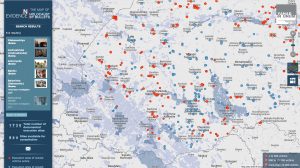
A screenshot of Yahad – In Unum’s killing sites map of western Ukraine.
YIU = Yahad – In Unum
A broad and long-term research project documenting wartime execution sites and mass graves of Jews and Roma in former Soviet-controlled areas, based on field work and interviews with local witnesses. YIU’s web resources include a map of locations in Ukraine where their team has conducted research and documented burial sites; Jewish cemeteries are often included as they were common sites for killing and mass burial. Each documented location includes historical data and descriptions plus transcripts of interviews; more information is available via direct contact with the organization. Field work and digital documentation efforts continue.
LT = Lo Tishkach European Jewish Cemeteries Initiative
The Lo Tiskach organization has researched and published data on more than 11,000 Jewish cemeteries and mass graves in Europe, with status reports on a selection of those in an effort to help preserve and protect the sites. Broken links, security mismatches, and a lack of visible activity since 2017 make navigating their website difficult, but the database remains functional and useful on their site. Within the western Ukrainian area of our study, Lo Tishkach has recorded more than 300 burial sites, an incomplete tally but more than any other organization. Much of the Ukrainian site data is excerpted from the original survey by the US Commission for the Preservation of America’s Heritage Abroad (now IAJGS), but with additional sites of original research.
Additional Sources for Further Research:
CJA = Center for Jewish Art: Bezalel Narkiss Index of Jewish Art
Within the huge online database of Jewish art objects documented in the Bezalel Narkiss Index, a subsection labeled “Jewish Funerary Art” presents a search form for finding information and images covering Jewish cemeteries. Cemetery search results present matzevot as art objects, and mass graves present memorials, but the burial sites themselves are also indexed and described. Searches can be filtered by town name, oblast, etc. There is overlap between this database and the data on the JGB source listed here.
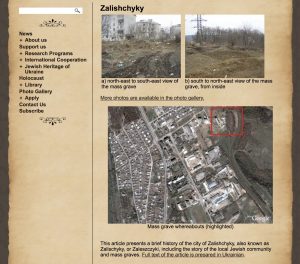
A screenshot of a portion of the FPC report on the Jewish mass graves in Zalischyky (Ternopil oblast).
FPC = Faina Petryakova Center for Judaica and Jewish Art
The Center’s website promotes Judaica and Jewish heritage in Ukraine, including heritage preservation work organized by the Union of Councils for Jews in the Former Soviet Union (UCSJ) and led by the UCSJ’s Ukraine Bureau director Meylakh Sheykhet. Focus pages on the website list more than 150 Jewish cemeteries and more than 30 Jewish mass graves across Ukraine which have been researched in detail by the organization; a high percentage of sites are in western Ukraine. A few of the sites have been documented online, and more information is available via direct contact with the organization.
VS = Virtual Shtetl
Originally founded by the Jewish Historical Institute Association, since 2012 Virtual Shtetl has been a project of the POLIN Museum of the History of Polish Jews in Warsaw. Documenting in database format many forms of Jewish culture within historical greater Poland, including western Ukraine, a key section of the data is a collection of articles on towns which do or did have Jewish residents – and thus community sites such as cemeteries and synagogues. Each town is researched by a variety of authors, both Virtual Shtetl staff and external volunteers. Within each town page are individual articles on Jewish burial sites, many with GPS coordinates and maps. Coverage of western Ukraine is not as complete as for contemporary Poland, and a number of the GPS pointers are incorrect, but the encyclopedic approach to town articles is helpful for context and broader study.
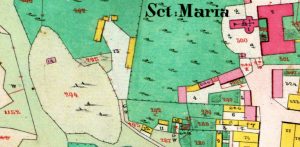
The large Jewish cemetery of Rozdil (Lviv oblast) west of town center, seen on an 1850 cadastral map.
GG = Gesher Galicia Map Room
A web project of the Jewish genealogy organization Gesher Galicia, the detailed original cadastral (property) maps primarily dating from the period of Austro-Hungarian Empire show individual towns and villages at high scale. Although the Map Room presents only a fraction of the hundreds of eastern Galician Jewish settlements which were surveyed one or more times up to WWI, a majority of the maps include one or more Jewish cemeteries. Austrian survey accuracy was high enough that cemetery locations and boundaries as they existed at the time of the survey can often be determined even when little or no visible sign of the cemeteries exists today.
SR = Shtetl Routes
A project of the Grodzka Gate – NN Theatre, a cultural center located in Lublin, Poland, Shtetl Routes promotes tourism and education around the former Jewish “shtetls” in the borderlands of Poland, Belarus, and Ukraine. In addition to cultural and historical studies of the region, western Ukraine is represented by deep visual studies of 13 towns and their Jewish heritage, including burial sites.
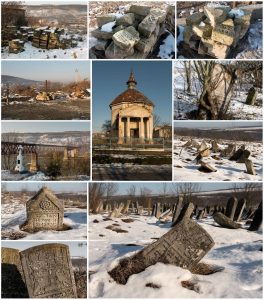
A screenshot of a portion of a Vanished World blog post about a journey through southwestern Ukraine in 2018.
VW = Vanished World
The photo blog site of Christian Herrmann, a noted photographer and researcher of Jewish cultural sites in central and eastern Europe, presents his visual and textual observations from journeys he has made (and continues to make) through several countries during the past decade, with a recurring emphasis on western Ukraine – former eastern Galicia and northern Bukovina. His research and focus on less well-known and less-maintained sites, shining light on the traces of Jewish life before they disappear into darkness, has led to a number of additions to the larger databases of burial grounds. Christian’s published books and exhibitions also help raise awareness of the fragility of all of these sites. His blog work is published under a Creative Commons license which permits non-commercial re-use with attribution, helpful for non-profit and volunteer promotional work on cemeteries.
JGB = Jewish Galicia and Bukovina
An Israel-based region-focused non-profit organization which researches and promotes a wide range of Jewish cultural history, including what they describe as Great Heritage (physical sites and buildings together with historical background and maps), JGB has identified and documented a handful of significant Jewish cemeteries in western Ukraine. Within those cemeteries and selected others, they have photographed and translated headstone epitaphs; more than 10 thousand headstones have been databased to date.
JOWBR = JewishGen Online Worldwide Burial Registry
A partner project of the IAJGS/JewishGen cemeteries database listed above, JOWBR is a names database covering individual burials at cemeteries. For western Ukraine, to date JOWBR lists fewer than 25 cemeteries in the three Galician oblasts, fewer than 10 cemeteries in the former Bukovina region, and more than 200 cemeteries in Transcarpathia; this in part reflects the selectively severe damage that Jewish cemeteries in former eastern Galicia suffered during and after WWII.
GA = Geder Avos Jewish Heritage Group
Founded in the 1960s and actively working today, Geder Avos restores and maintains Jewish burial sites across Europe; a significant part of its work is the rebuilding of ohels over the burial sites of historically-recognized tzadikim. Their website documents a selection of their past projects, including several sites in western Ukraine; their full project history, although not listed on the web, includes a number of additional sites in western Ukraine.
Other Sources:
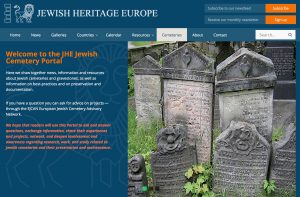
A screenshot of the Jewish Heritage Europe Cemeteries Portal.
Other web resources for information on cemeteries and mass graves in western Ukraine, although not databases or catalogs of sites, are included in the tables here to supplement the compilations for sites where little or no substantial data yet exists. Those sources include:
VY = Vasyl Yuzyshyn, a driver, guide, and interpreter who frequently joins scientific and historical tours of Jewish heritage sites throughout Ukraine and other central European countries. Through interviews with local people and other research, Vasyl is often able to locate obscured Jewish cemeteries and mass graves during travel with RJH and others.
JHE = Jewish Heritage Europe, for articles by the site coordinator and other authors which detail locations in western Ukraine.
RJH = Rohatyn Jewish Heritage, for sites in the Rohatyn raion of the Ivano-Frankivsk oblast.
Rada = Linked pages on websites of regional or municipal council (Рада) administrations which describe and/or locate Jewish cemeteries and mass graves.
A small number of links to other websites with information about individual burial sites, towns, or other purposes also appear here, if no other source has identified the locations.
To Add to the Compilation:
Identifying information (GPS and description) for known Jewish cemeteries and mass graves in western Ukraine which are not listed in the tables on these pages may be forwarded for research and inclusion to the contacts at Rohatyn Jewish Heritage. We welcome any additions, to close gaps in the data and the historical record.
Identified Jewish Burial Sites on the Map
The interactive map below locates and labels all of the identified Jewish burial sites in western Ukraine, covering both cemeteries and mass graves in contrasting colors. Because there are hundreds of burial sites shown on the map, the pin set is very dense, and it helps to zoom the map to distinguish individual sites. Although all or nearly all cemeteries are displayed on the map, only the mass grave sites with precisely-defined locations are shown here; for many mass grave sites, only approximate or unverified locations are known, and research continues to better locate them for memorial purposes.
A Note of Thanks
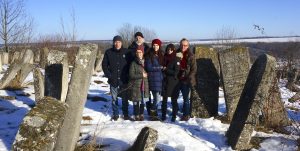
Marla and Jay visiting the Jewish cemetery of Korolivka (Ternopil oblast) with friends in winter 2018. Photo © RJH.
We are deeply grateful for the years-long effort and careful contribution that the sources listed on this page have given to identifying Jewish burial sites in western Ukraine and beyond. We use their data frequently and admire their dedication to the preservation of heritage and memory of the people who lived and died here. We would especially like to thank the teams of ESJF European Cemeteries Initiative and Yahad – In Unum with whom we have worked for years, and who continue to generously contribute information and advice to multiple aspects of this and our other projects.
Our knowledge of the Jewish burial sites in western Ukraine comes from more than published websites, of course. For many cemeteries and mass grave locations, we have visited the sites ourselves to see them with our own eyes, to monitor changes over the past decade, and to reflect on the communal and individual histories of these places. We have visited only about half of the hundreds of sites listed on the linked pages here, but that number already exceeds 250 cemeteries and mass graves. Often we have traveled with a special group of friends and colleagues, each of whom shares our interest in regional heritage sites and brings unique knowledge and perspective to our itineraries, and all of whom have contributed to our project work in several ways. For their research, advice, encouragement, and companionship, we give our thanks to Vasyl Yuzyshyn, Christian Herrmann, Iryna Nebesna, and Anna Zolotnyuk.

